Ontario << on TAR ee `oh` >> has more people than any other Canadian province. More than a third of Canada’s people live in Ontario. Service industries provide Ontario with its greatest source of income. Ontario’s manufacturing industries produce about as much as those of the nine other provinces combined. Ontario is a leading Canadian province in farm income and the production of many minerals.
Toronto is the capital of the province, and the Toronto area is Canada’s leading manufacturing center. Ottawa, the capital of Canada, lies on the Ottawa River in southeastern Ontario.
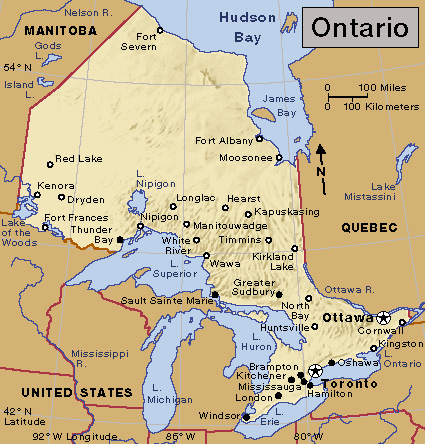
Ontario has a larger area than any other Canadian province except Quebec. It is the southernmost province, but it also extends so far north that some of the ground beneath the surface is permafrost (permanently frozen ground).
The busy factories, mills, and plants of Ontario have given it the nickname Manufacturing Heartland of Canada. Most industries are in the warm southern region, south of Lake Nipissing. About 95 percent of the people live there, on about 12 percent of the land area. The province’s richest manufacturing region, called the Golden Horseshoe, curves around the western shores of Lake Ontario.
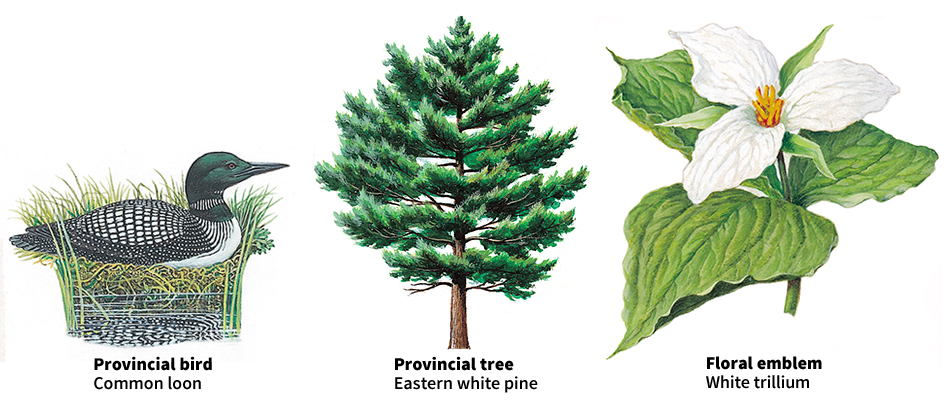
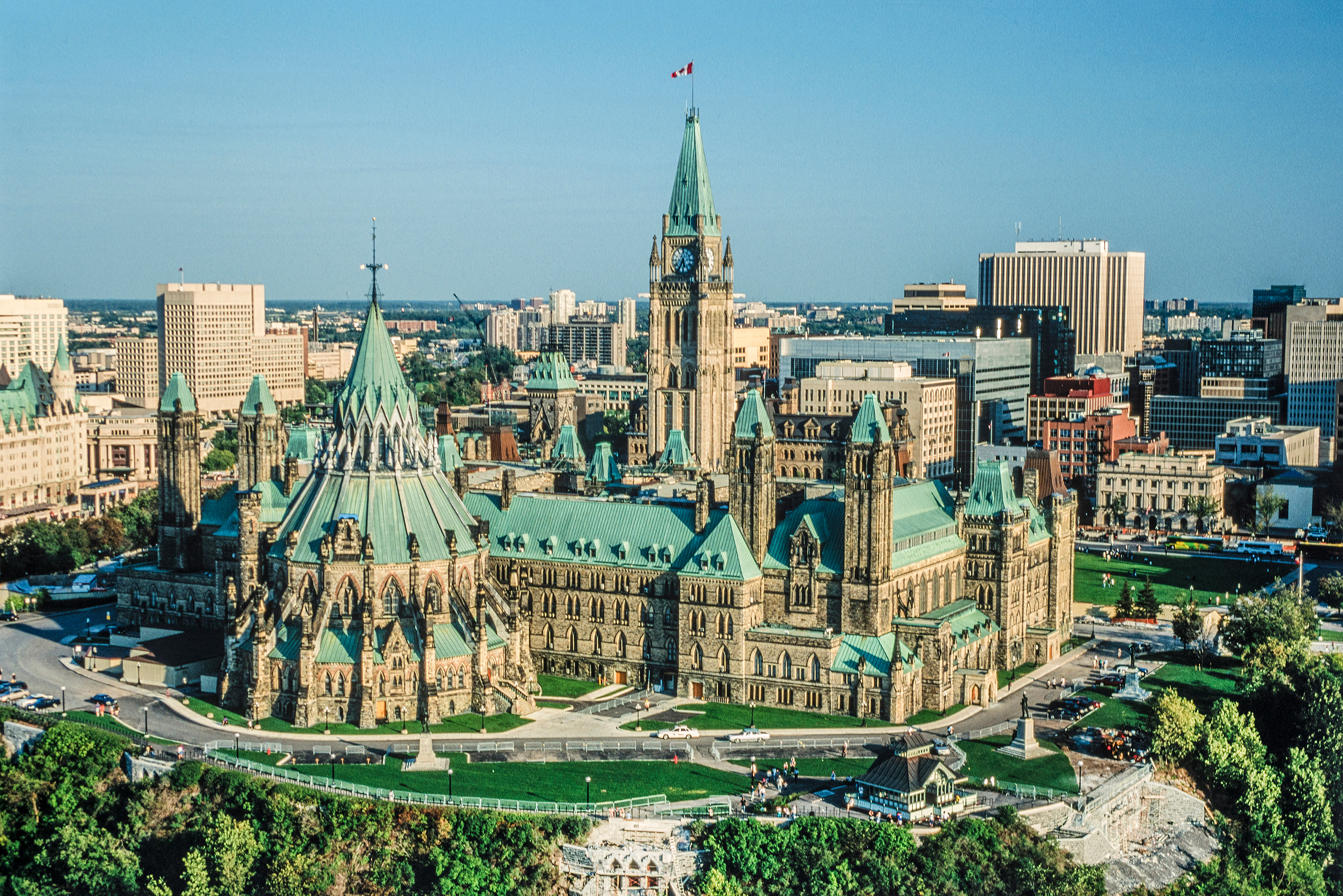

Ontario’s major industry is manufacturing automobiles. Most of the province’s automobile plants are in the Golden Horseshoe. Almost all the automobiles made in Canada come from there. Hamilton, a city in the Golden Horseshoe, is Canada’s greatest iron and steel center. Nearby is Toronto, one of the chief Canadian ports on the Great Lakes. The region’s varied products travel from Toronto to many parts of the world by way of the St. Lawrence Seaway.
The mines of Ontario account for much of Canada’s mineral production. Deposits near Greater Sudbury yield much of the world’s supply of nickel. One of the major known uranium deposits in the world lies near Elliot Lake. Ontario is also one of North America’s leading producers of gold.
Ontario is Canada’s leading producer of eggs and poultry and also leads in the production of fruits and vegetables. The province provides about a fifth of Canada’s farm products. Herds of beef and dairy cattle graze in rich pastures between Lake Huron and Lake Ontario. Tobacco grows along Lake Erie, and orchards thrive in the Niagara fruit belt. Northern Ontario has thick forests that provide wood for the pulp and paper industry. Trappers catch fur-bearing animals there, and campers hunt and fish.
The province’s name came from Indigenous (native) Iroquoian-speaking peoples who lived in the Ontario region when French explorers first arrived. The word Ontario may mean beautiful lake. Or it may mean rocks standing high or near the water, referring to Niagara Falls. These spectacular falls attract many visitors. Niagara Falls ranks among the greatest natural sources of hydroelectric power in North America.
Ontario, together with New Brunswick, Nova Scotia, and Quebec, was one of the original provinces of Canada. For the relationship of Ontario to the other provinces, see Canada; Canada, Government of; Canada, History of.
People
Population.
The 2021 Canadian census reported that Ontario had 14,223,942 people. The population of the province had increased about 6 percent over the 2016 figure of 13,448,494.
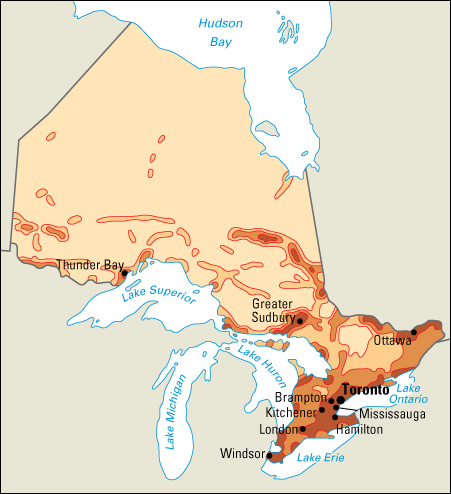
The great majority of Ontarians—95 of every 100 people—live in 12 percent of the province’s land area. This heavily populated region, the southernmost part of the province, lies south of Lake Nipissing. The area includes all of Ontario’s metropolitan areas except those of Greater Sudbury/Grand Sudbury and Thunder Bay. Ontario has 16 census metropolitan areas as defined by Statistics Canada (see Metropolitan area).
About 85 percent of the people of Ontario live in urban areas. Ontario contains more cities with populations of 50,000 or more than any other Canadian province.
Toronto is the largest city in Ontario and in Canada. Ontario’s other large cities include Brampton, Hamilton, Kitchener, London, Markham, Mississauga, Ottawa, Windsor, and Vaughn. See the separate articles on the cities of Ontario listed in the Related information section that accompanies this article.
About 70 percent of the people in Ontario were born in Canada. The province also has many people born in China, India, Italy, the Philippines, and the United Kingdom. Although many Ontarians have some English ancestry, the province is extremely diverse. There are also many people with Chinese, French, German, Irish, Italian, and Scottish ancestry.
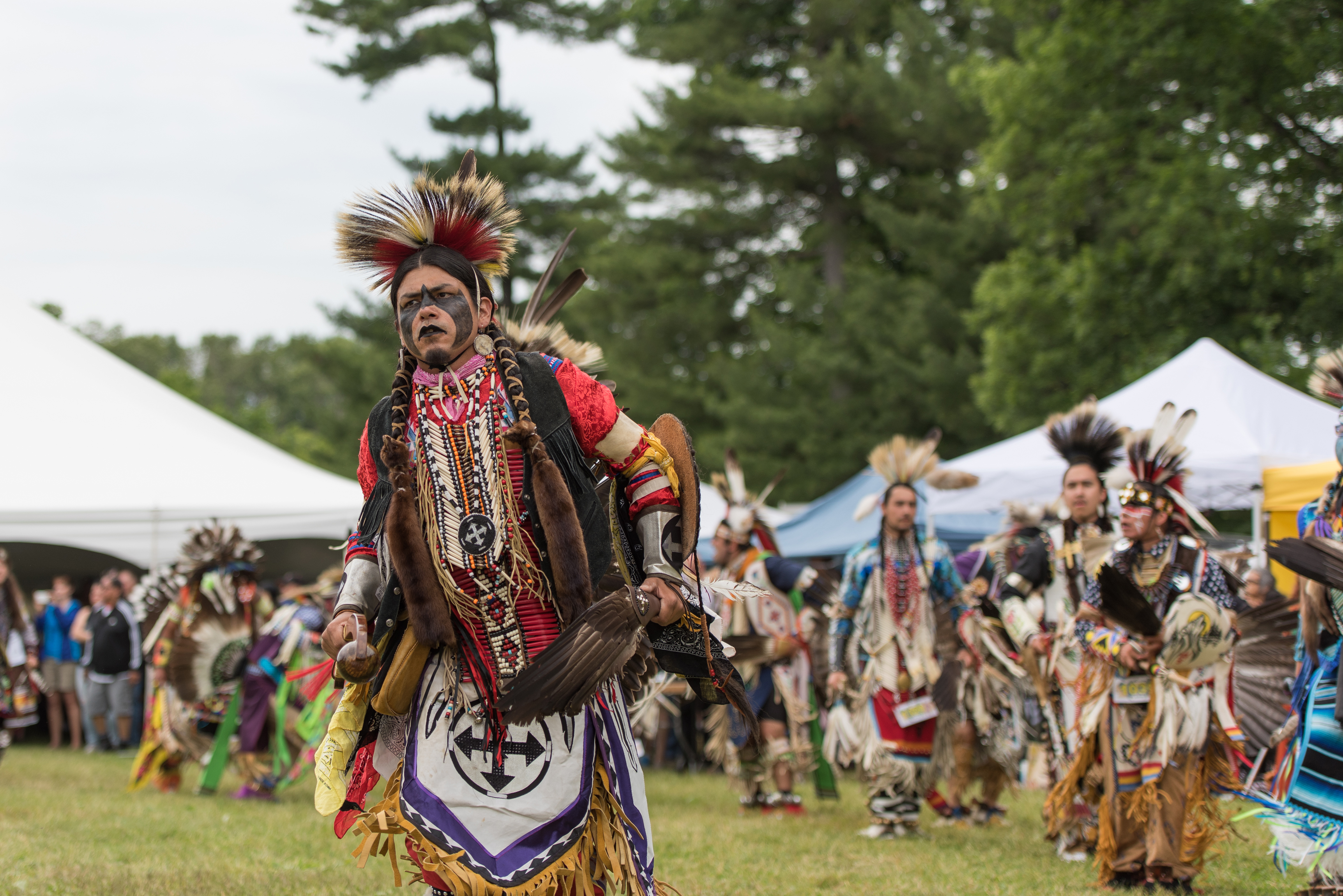
Among Canada’s provinces and territories, Ontario has the largest Indigenous population. The First Nations, Inuit, and Métis are Canada’s three main Indigenous groups. Ontario also has Canada’s largest First Nations population. There are more than 200 First Nations reserves in Ontario, mostly in the northern part of the province.
Schools.
The first common (elementary) schools in the Ontario region were established during the late 1780’s. In 1807, Ontario’s provincial government provided by law for a grammar (high) school in each of the province’s eight districts. In 1816, the government provided for common schools throughout the province. Ontario’s school system took its present basic form during the 1870’s. Grammar schools became known as high schools or collegiate institutes. Common schools were called free schools. Free schools were financed by local taxes and government grants.

Today, Ontario has public schools and Roman Catholic schools. Both types of schools are supported by taxes and are under the authority of the Ministry of Education. English is the language of instruction in most schools. However, the province also has some French-language schools. Attendance from age 6 to age 18 is required by law.
Ontario’s oldest university is the University of Toronto, established by British royal charter in 1827. It opened in 1843 as King’s College and became the University of Toronto in 1850. Today, Ontario has more than 45 publicly funded colleges and universities. It also has a number of publicly funded Indigenous institutes—that is, Indigenous governed and operated postsecondary educational institutions.
Libraries.
Ontario’s first subscription library was established in 1800 at Niagara. By 1867, Ontario had more than 60 mechanics’ institutes, which provided books for working people. Ontario passed Canada’s first public-library legislation, the Free Libraries Act, in 1882.
Library and Archives Canada, the National Science Library, the Library of Parliament, and the Supreme Court of Canada Library are in Ottawa. The National Gallery of Canada Library and Archives, also in Ottawa, includes an extensive collection of visual-arts literature. The Thomas Fisher Rare Book Library of the University of Toronto includes well-known collections of Canadian, English, and Italian literature.
Museums.
The Royal Ontario Museum in Toronto has galleries containing archaeology, art, history, and natural history exhibits. The Ontario Science Centre, also in Toronto, features exhibits and demonstrations dealing with science and technology. National museums in Ottawa include the Canadian Museum of Nature, with collections covering botany, earth sciences, and vertebrate and invertebrate animals; the Canada Science and Technology Museum, with exhibits on communications, industrial technology, natural resources, and transportation; and the National Gallery of Canada, which features artworks from Canada and other parts of the world.
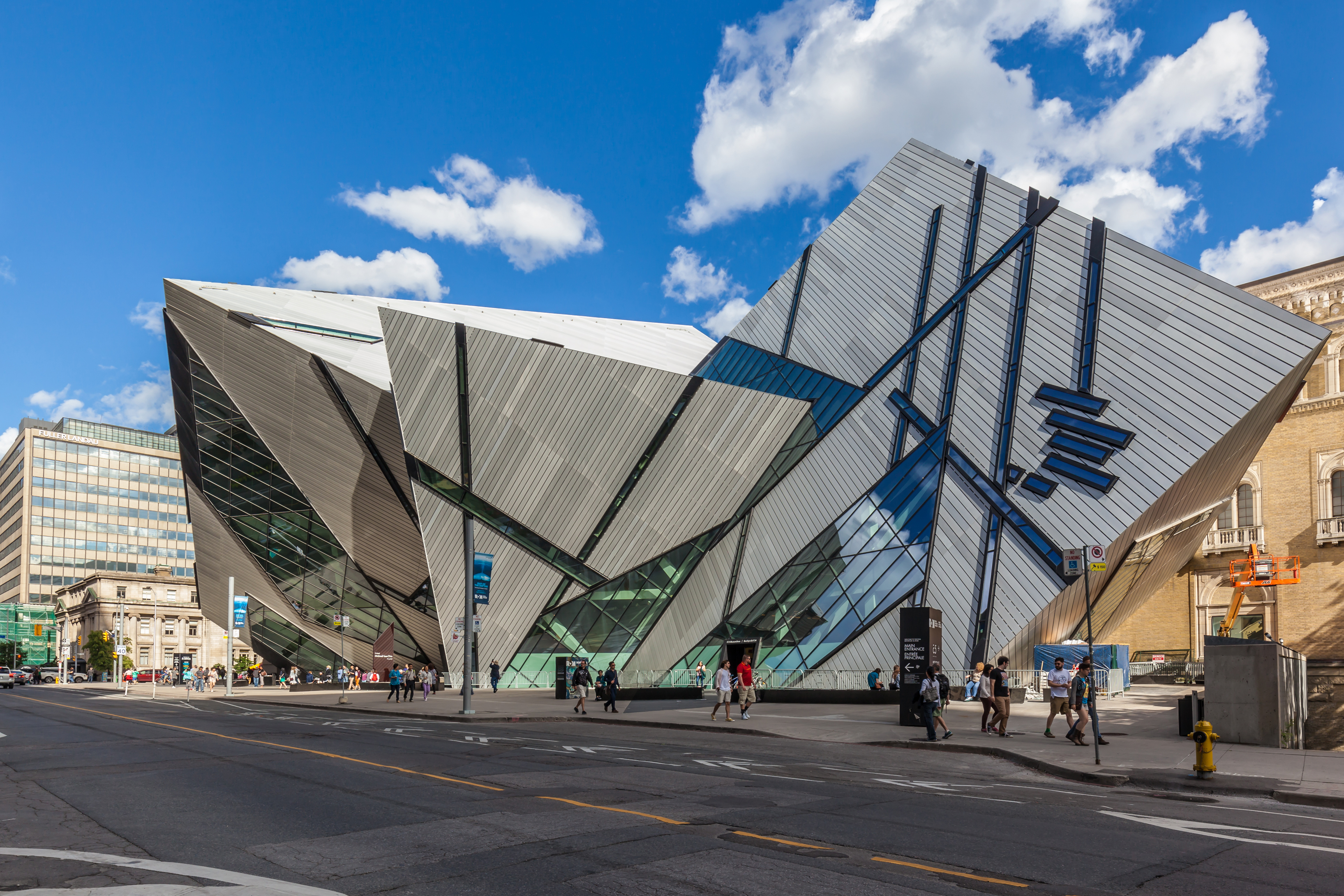
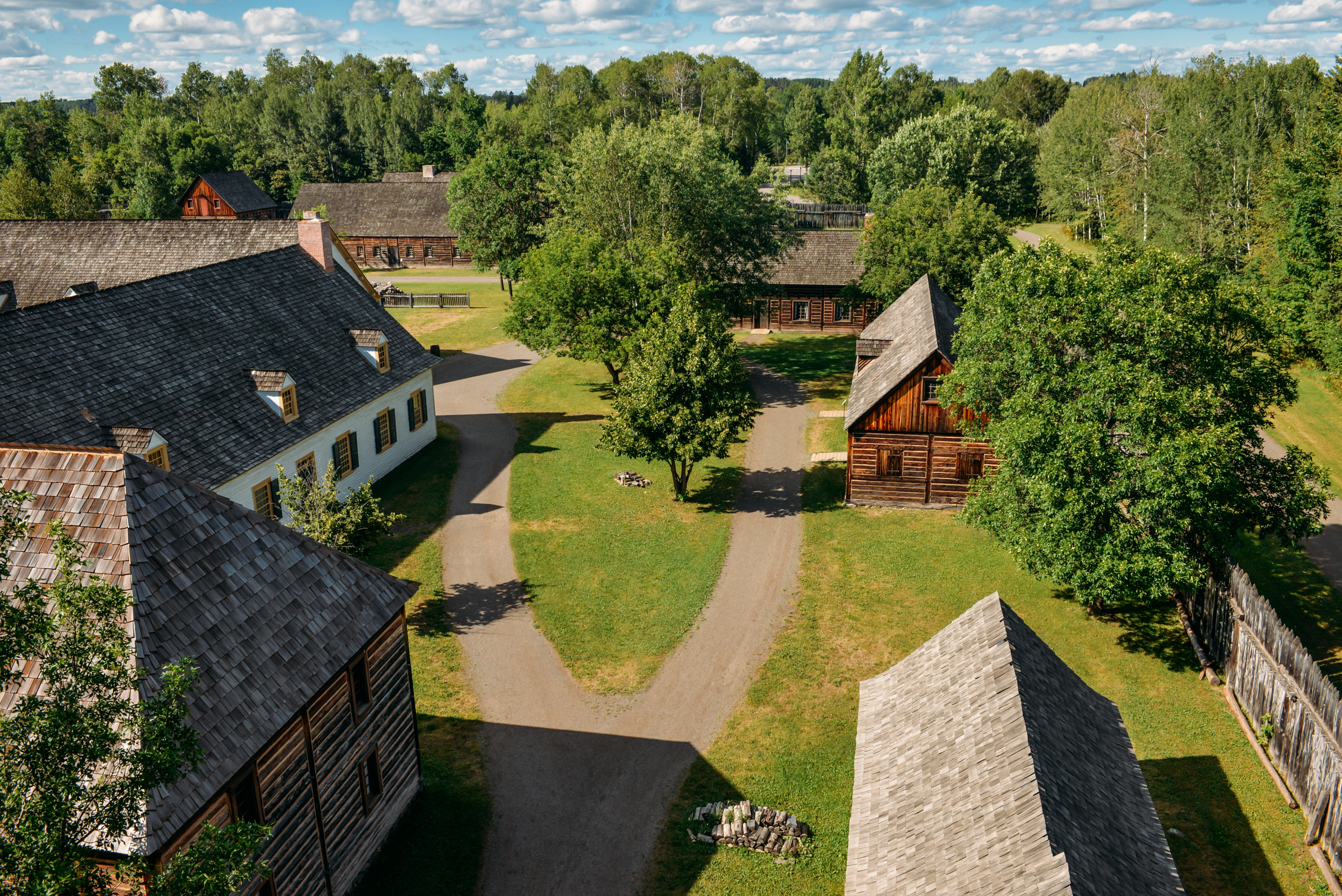
Fort William Historical Park in Thunder Bay is a reconstruction of a local fur-trading post of the early 1800’s. Fort William operated as the inland headquarters of the North West Company. It became the world’s largest fur trading post. Sainte-Marie Among the Hurons, near Midland, is a re-creation of a fortress and headquarters for Jesuit missionaries of the 1600’s. The fortress was Ontario’s first European community. Ottawa’s Canadian War Museum displays art, artifacts, and memorabilia representing the nation’s military history.
Visitor’s guide
More than 100 million tourists visit Ontario every year. More than 250,000 lakes and rivers in the province offer a variety of recreational activities, including fishing and boating. Ontario’s forests attract campers and hunters.
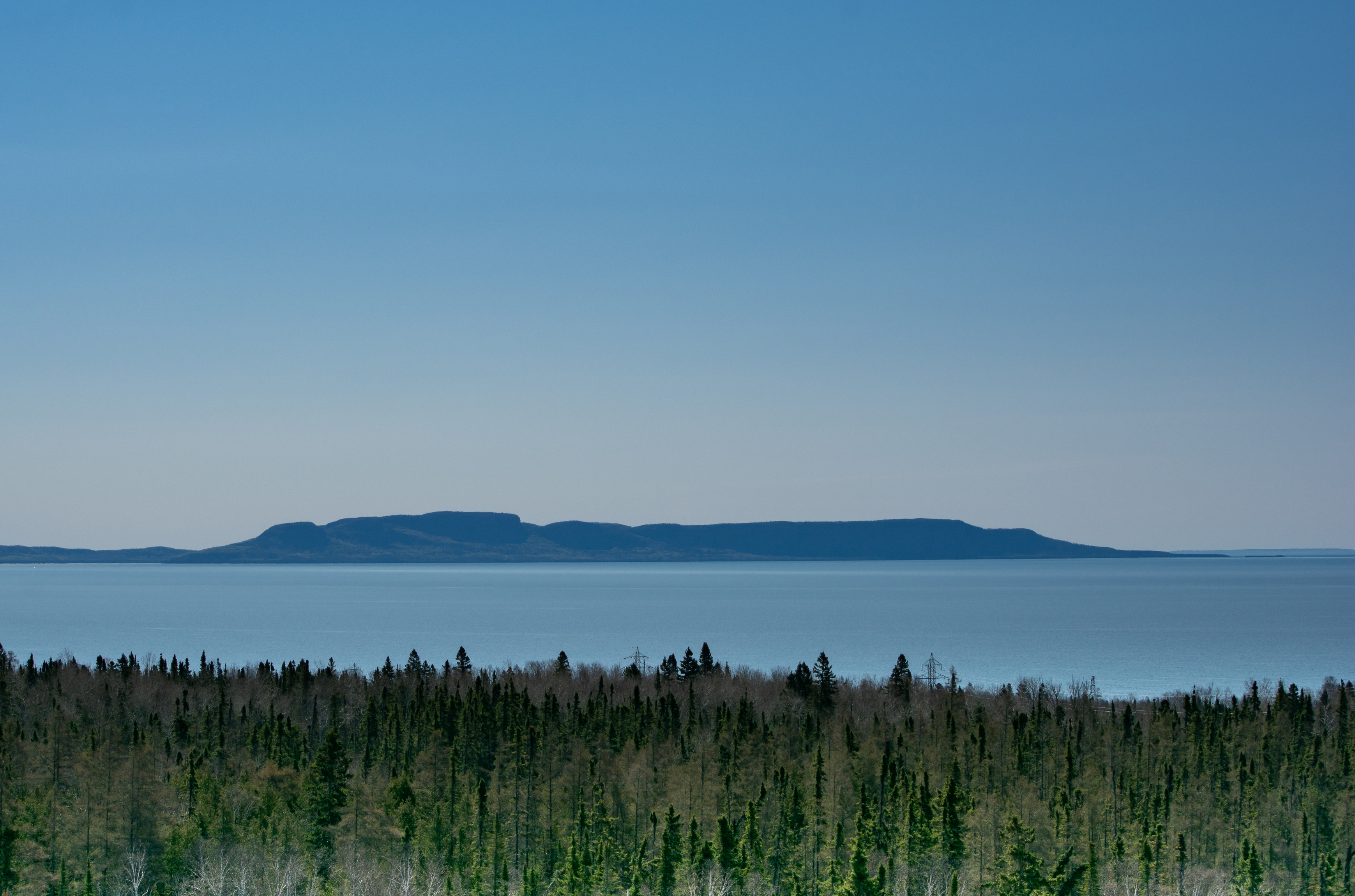

The sunny, southernmost resort region of the province, along Lakes Erie and Ontario, is known as Canada’s Sun Parlor_and _Canada’s Banana Belt. Boat cruises take vacationers through the Thousand Islands and other islands in Ontario waters. The Haliburton Highlands and the Kawartha and Muskoka lakes near Toronto are famous resort areas. Low, wooded hills line their shores. The landscape becomes more rugged toward the northern and northwestern vacationlands of James Bay and Lake of the Woods. Many hunters fly in seaplanes to the far northern lakes to hunt bears, geese, moose, and other game.
Ontario is the home of two major annual drama festivals. The Stratford Festival, held in Stratford, features the plays of William Shakespeare. The Shaw Festival, at Niagara-on-the-Lake, presents plays by George Bernard Shaw and other dramatists of his time.
Land and climate
Land regions.
Thousands of years ago, glaciers moved across Ontario, eroding and depositing materials and so helping to shape the land. Today, Ontario has four main land regions. They are, from north to south: (1) the Hudson Bay Lowland, (2) the Canadian Shield, (3) the St. Lawrence Lowland, and (4) the Great Lakes Lowland.
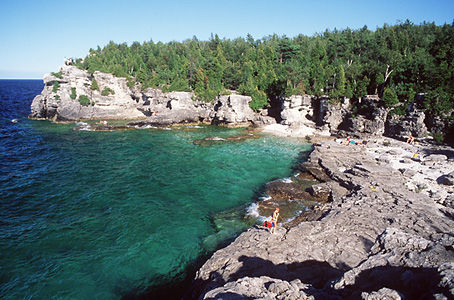
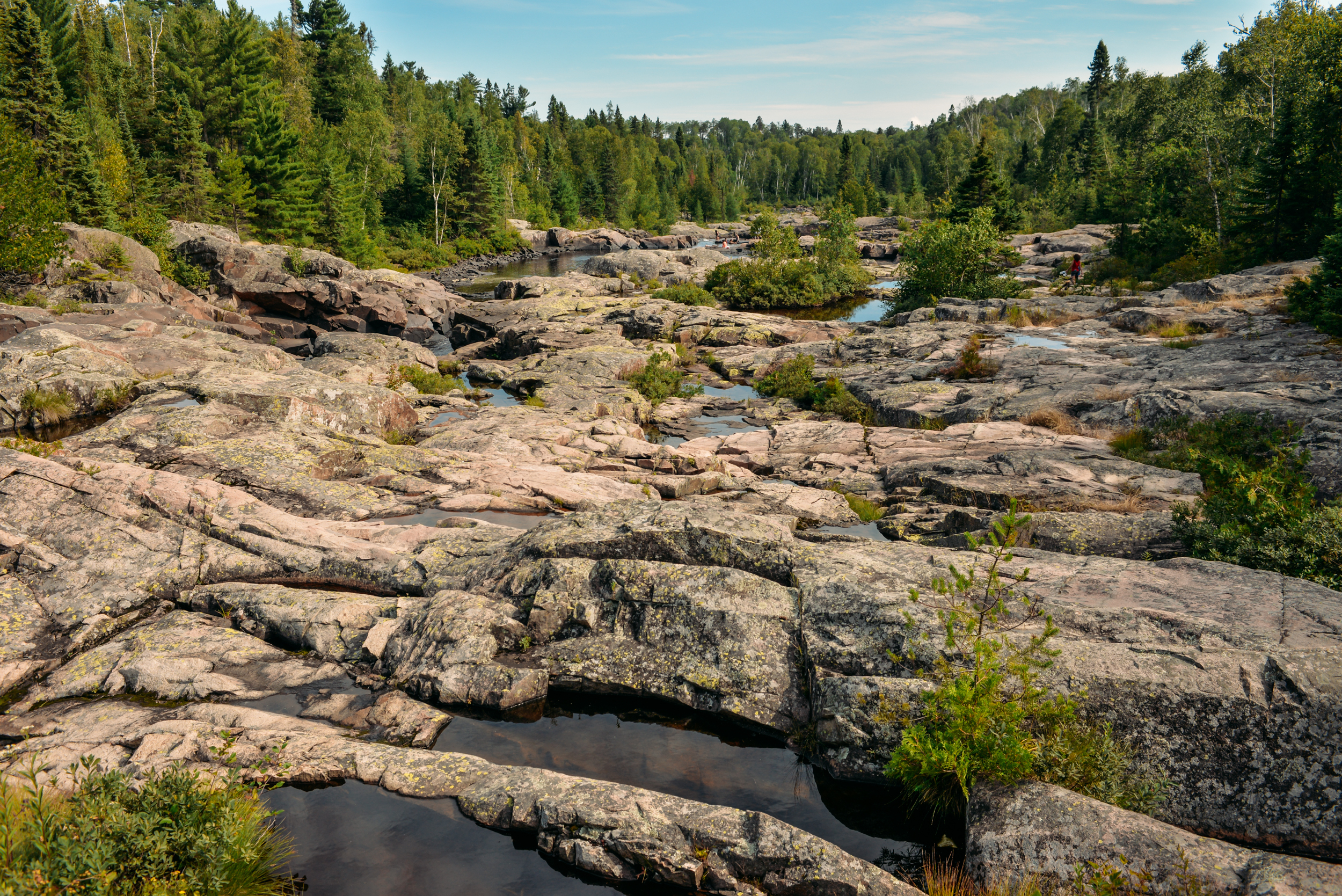

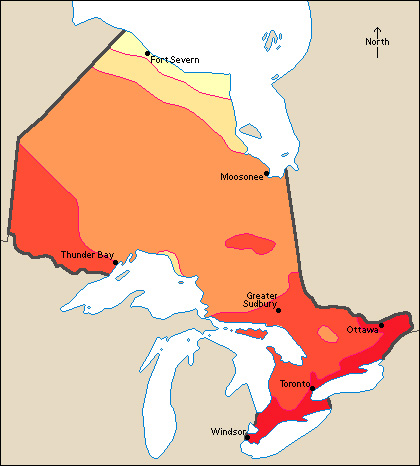
The Hudson Bay Lowland
curves around the southern part of Hudson Bay and extends as far south as Kesagami Lake. This flat region of northern Ontario is poorly drained, and much of it is covered by muskeg (peat bogs). The lowland includes a narrow belt of permafrost (permanently frozen ground) near the Arctic.
The Canadian Shield
is a vast, horseshoe-shaped region that covers almost half of Canada and part of the northern United States. This low, rocky region covers more than half of Ontario. It contains some of Earth’s oldest rocks. These rocks date from Precambrian times, which ended more than 500 million years ago. Small lakes and rivers surrounded by wooded hills attract many vacationers. The highest point in Ontario rises 2,275 feet (693 meters) in Timiskaming District.
The Canadian Shield is rich in game, minerals, and timber. Patches of clay, scattered throughout the region, were formed by deposits in ancient glacial lakes. The largest clay area, known as the clay belt, extends from the Hearst area to the Quebec border. Farmers raise a variety of crops, including grains and vegetables, in the rich clay soil. Beef and dairy cattle graze on fenced grasslands in the region. See Canadian Shield.
The St. Lawrence Lowland
runs along the St. Lawrence River. In Ontario, it forms the tip of the wedge of land between the Ottawa and St. Lawrence rivers. Low hills rise above the fertile valleys. Farmers grow fruits, grains, and vegetables in this region. Dairy farming is extensive there.
The Great Lakes Lowland
lies along much of the Great Lakes in Canada and the United States. In Ontario, the region touches Lakes Erie, Huron, and Ontario. Great quantities of many crops are grown in the fertile gray-brown soil of the low, flat, southwestern section. The land rises gently in the northeast, where beef and dairy cattle are raised. The Niagara Escarpment, a high cliff or ridge, extends 250 miles (402 kilometers) from Manitoulin Island, through Bruce Peninsula, to Niagara Falls. The escarpment forms a natural shelter for Ontario’s best fruit-growing belt. Many of Canada’s largest cities are in the Great Lakes Lowland.
Shoreline and coastline.
Ontario’s southern shores of bays, narrow inlets, and sandy beaches stretch about 5,300 miles (8,500 kilometers). This shoreline, including about 2,400 miles (3,900 kilometers) of offshore island shoreline, is on Lakes Erie, Huron, Ontario, and Superior. Ontario’s Manitoulin Island is the world’s largest inland island. It has an area of 1,067 square miles (2,765 square kilometers) in Lake Huron.
Oceangoing ships use the St. Lawrence Seaway to reach the Great Lakes ports of Ontario. These inland seaports include Hamilton, Port Colborne, Sarnia, Sault Ste. Marie, and Toronto. Thunder Bay on Lake Superior is a major Canadian grain port. Northern Ontario has a coastline of about 750 miles (1,210 kilometers) on Hudson Bay and James Bay.
Rivers, waterfalls, and lakes
cover a sixth of the province. A land rise separates the Ontario streams that flow into the Great Lakes from those that empty into the Ottawa River or Hudson Bay. Many lakes and rivers, some linked by canals, are important transportation routes.
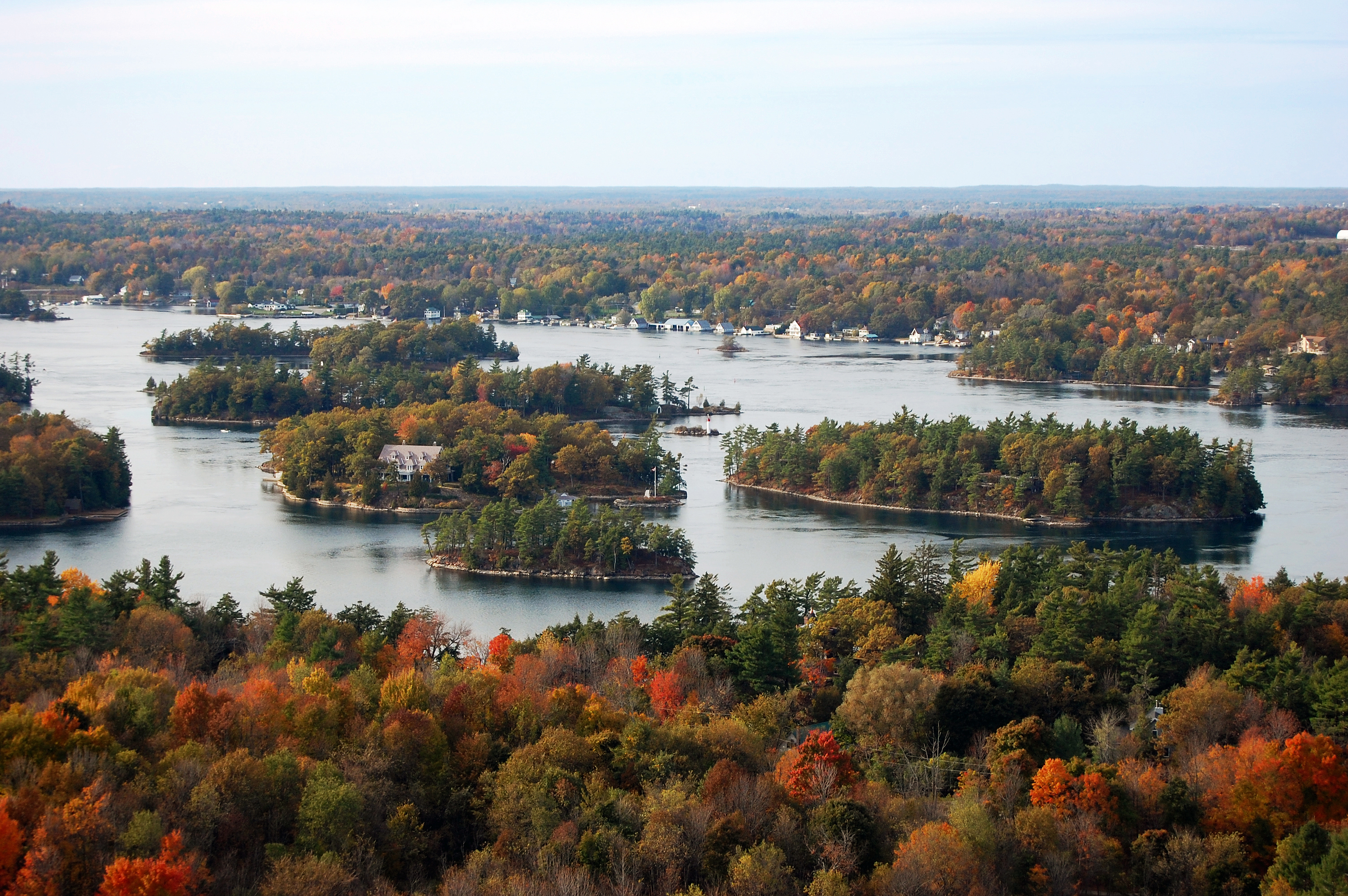
The St. Lawrence River, a great natural highway for commerce, has contributed much to the growth of Ontario’s economy. The river was enlarged in the 1950’s to create the St. Lawrence Seaway, enabling ocean vessels to reach the Great Lakes. Hydroelectric plants on the Niagara and other rivers provide Ontario with cheap power. The mighty Horseshoe Falls are formed by the Niagara River passing over the Niagara Escarpment.
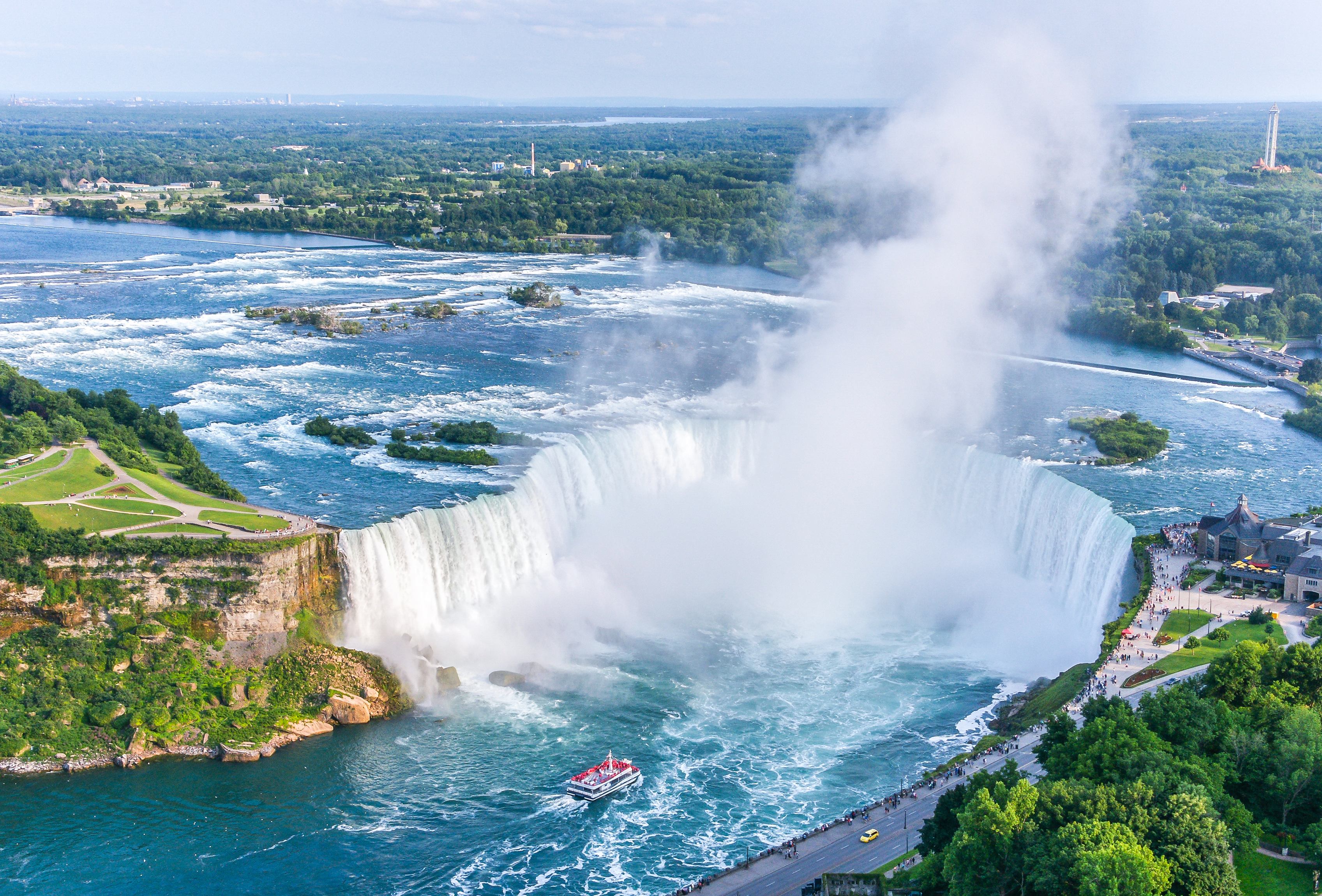
The Ottawa River was part of the early fur traders’ route to Georgian Bay and the west. This river flows into the St. Lawrence River. The Ottawa drains the part of southern Ontario that does not lie in the Great Lakes basin. Other important southern rivers include the French, Grand, Thames, and Trent. The Detroit River, Lake St. Clair, and the St. Clair River link Lakes Erie and Huron. The St. Marys River connects Lakes Huron and Superior.
Ontario has about 400,000 lakes. Besides the Great Lakes, the largest lakes in the province are Lake of the Woods and Lakes Abitibi, Nipigon, Nipissing, and Seul.
Plant and animal life.
Ontario has about 180,000 square miles (466,000 square kilometers) of forests. Northern Ontario has huge forests of balsam, pine, spruce, and other softwoods. It also has birch and poplar. Thick forests of hardwoods such as ash, beech, elm, maple, and walnut once covered southern Ontario. Most of the timber in the south was cut during the 1800’s, and the forests there now have second-growth trees.
Wildflowers are plentiful in Ontario. Trilliums and bloodroots blossom in spring. Autumn brings masses of asters and wild carrot blooms. Northern lakeside hills are thick with wild blueberry bushes in forest clearings. Shrubs and mosses grow in the far northern areas, where frost stays deep in the ground. Tamarack and spruce, which grow there, do not reach their usual height in this cold, poorly drained region.
Moose and caribou roam the wooded northlands of Ontario. Shy white-tailed deer pause to drink from streams in the Canadian Shield. People in this region often see the tracks of black bears. Fur-bearing animals such as beavers, minks, muskrats, foxes, and otters live throughout Ontario. Snowshoe hares are also plentiful in all parts of the province. Raccoons and rabbits are abundant in southern Ontario. Birds of Ontario include ducks, geese, and ruffed grouse. The haunting cries of loons pierce the air at dusk over Ontario’s lakes. Brook trout, lake trout, northern pike, whitefish, and yellow pickerel are found in the lakes and rivers.
Climate.
Due to its latitude and winds from the Great Lakes, southern Ontario has a milder climate than the rest of the province. Northern Ontario gets cold waves from the Arctic, or from the northwestern prairies. The record high temperature, 108 °F (42 °C), occurred in Biscotasing on July 20, 1919, in Atikokan on July 11 and 12, 1936, and in Fort Frances on July 13, 1936. The lowest temperature, –73 °F (–58 °C), occurred in Iroquois Falls on Jan. 23, 1935. 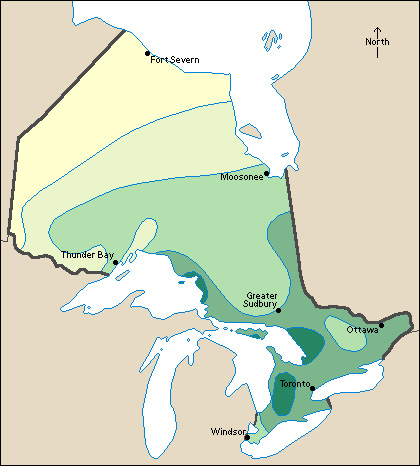
The average January temperature in southern Ontario ranges from 14 °F (–10 °C) in Ottawa to 25 °F (–4 °C) in Windsor. The average July temperature is 66 °F (19 °C) in Greater Sudbury and 73 °F (23 °C) in Windsor. The temperature in northern Ontario in January averages –9 °F (–23 °C) at Big Trout Lake (also called Kitchenuhmaykoosib Inninuwug) and –4 °F (–20 °C) at Moosonee. The temperature in July averages 61 °F (16 °C) at Big Trout Lake and 66 °F (19 °C) at Sioux Lookout.
Ontario’s average annual precipitation (rain, melted snow, and other moisture) averages 26 inches (65 centimeters) in the northern part of the province to 33 inches (85 centimeters) in the southern part. Annual snowfall in most of Ontario ranges from 47 to 118 inches (120 to 300 centimeters).
Economy
The highly developed industries of Ontario make it one of the richest economic regions of North America. Service industries make up the largest part of the province’s gross domestic product (GDP)—the total value of goods and services produced in the province in a year. Ontario has a higher GDP than any other province. It leads the provinces in business and high-technology services and in the manufacture of high-technology and industrial products.
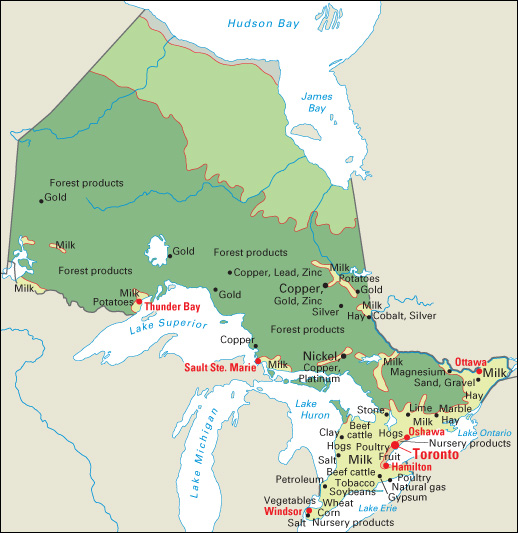
The economy of Ontario benefits from the province’s location near key North American population centers and waterways. Ontario is close to many large U.S. cities, which provide markets for the province’s goods and services. Several major U.S. corporations have large operations in Ontario. The St. Lawrence Seaway provides Ontario’s Great Lakes ports with an outlet to the Atlantic Ocean. Thus, ships can travel to and from Ontario ports from any ocean port in the world.
Natural resources.
The great forests and abundant wildlife of Ontario are valuable natural resources. Other important resources of the province include fertile soils, many mineral deposits, and a plentiful water supply.
Soil.
The soils of the northernmost parts of Ontario are frozen the year around. The Hudson Bay Lowland’s soils consist mostly of clay and marshes of moss called muskeg. Thin soils cover ancient rock in most of the Canadian Shield. Near the Quebec border, glacial clays and silt cover the fertile clay belts of the Cochrane and Teniskaming districts. The St. Lawrence and Great Lakes lowlands are Ontario’s chief farming regions. The St. Lawrence Lowland has black loams and well-drained sands over limestone and shale. The Great Lakes Lowland has rich, sandy soils.
Minerals
are found throughout central and northern Ontario in the rocks of the Canadian Shield. The Sudbury Basin, in the southern part of the Canadian Shield, is the greatest single source of Ontario’s mineral wealth. Much of the world’s nickel comes from this district. The ores there also contain cobalt, copper, gold, platinum, and silver. Other areas in the Canadian Shield produce copper, gold, nickel, and zinc. The three Hemlo area mines, on the north shore of Lake Superior, produce about 1 million troy ounces (32,000 kilograms) of gold annually. A gold mine in Red Lake, in northwestern Ontario, is one of the largest in the world. The province’s other mined products include cement, lime, salt, sand and gravel, and stone.
Service industries,
taken together, account for about four-fifths of both Ontario’s GDP and its employment. Service industries are especially important in Toronto and the other major urban areas of southern Ontario.
Toronto, the provincial capital, is the center of government activities. The city is also the nation’s leading financial center. Most of Canada’s largest banks, insurance companies, and property developers have headquarters there. The Toronto Stock Exchange is one of the largest in North America. Many of Canada’s largest hospitals and law firms are in Toronto. The city is also the home of OCAD University, Toronto Metropolitan University (formerly Ryerson University), the University of Toronto, and York University.
Service industries are also important outside of Toronto. Federal government activities are based in Ottawa. Large universities at Hamilton, London, Ottawa, and Waterloo employ many people. Rapid population growth in such metropolitan areas as Kitchener, Oshawa, and Ottawa has benefited Ontario’s real estate companies by increasing the demand for housing in the province. Each year, more tourists visit Ontario than any other Canadian province. Restaurants, hotels, and other service industries benefit from tourist spending.
Manufacturing
is one of Ontario’s most important economic activities. About two-fifths of Canada’s industrial workers live in Ontario. These workers produce about two-fifths of the country’s manufactured products. The Toronto area ranks as Canada’s leading industrial center. 
The production of transportation equipment is one of Ontario’s chief manufacturing industries. Automobile manufacturing is the main part of this industry. Most of Canada’s automobile manufacturing takes place in southern Ontario. Several major automobile companies have large assembly plants there. Many trucks are also produced in Ontario. Automobile parts are manufactured in many cities, including Barrie, Burlington, Guelph, London, Mississauga, Toronto, and Windsor. Hamilton is Ontario’s major steel center.
Chemicals, electronics, and plastic products are also important parts of Ontario’s manufacturing industry Most of Ontario’s chemical products are manufactured in Sarnia and Toronto. Telecommunications and computer equipment are leading types of electronic equipment made in Ontario. The manufacture of electronic equipment is based mainly in the Toronto and Ottawa areas. Packaging materials rank among Ontario’s leading plastics products. Toronto is also the home of much of Ontario’s plastics manufacturing industry.
The processing of agriculture and forest products is also important. Toronto is a major North American meat-packing center. Fruits and vegetables grown in the Great Lakes region of Canada are processed in Ontario factories. Plants in the province produce large quantities of milk and other dairy products. Ontario’s mills process Canadian-grown wheat into flour and prepared baking mixes. Beer, liquor, and soft drinks are the leading beverage products. Pulp and paper mills and sawmills are also important to the province’s economy.
Agriculture.
Ontario’s farms cover about 5 percent of the province’s land area. Crops account for over half of Ontario’s farm production.
Milk is one of the leading sources of farm income. The raising of beef cattle and hogs are also important. Beef and dairy cattle graze on pastureland between the southeastern shores of Lake Huron and the lower western shores of Lake Ontario. Dairying is also important eastward along Lake Ontario and the St. Lawrence River. Farmers in southern Ontario raise large numbers of hogs.
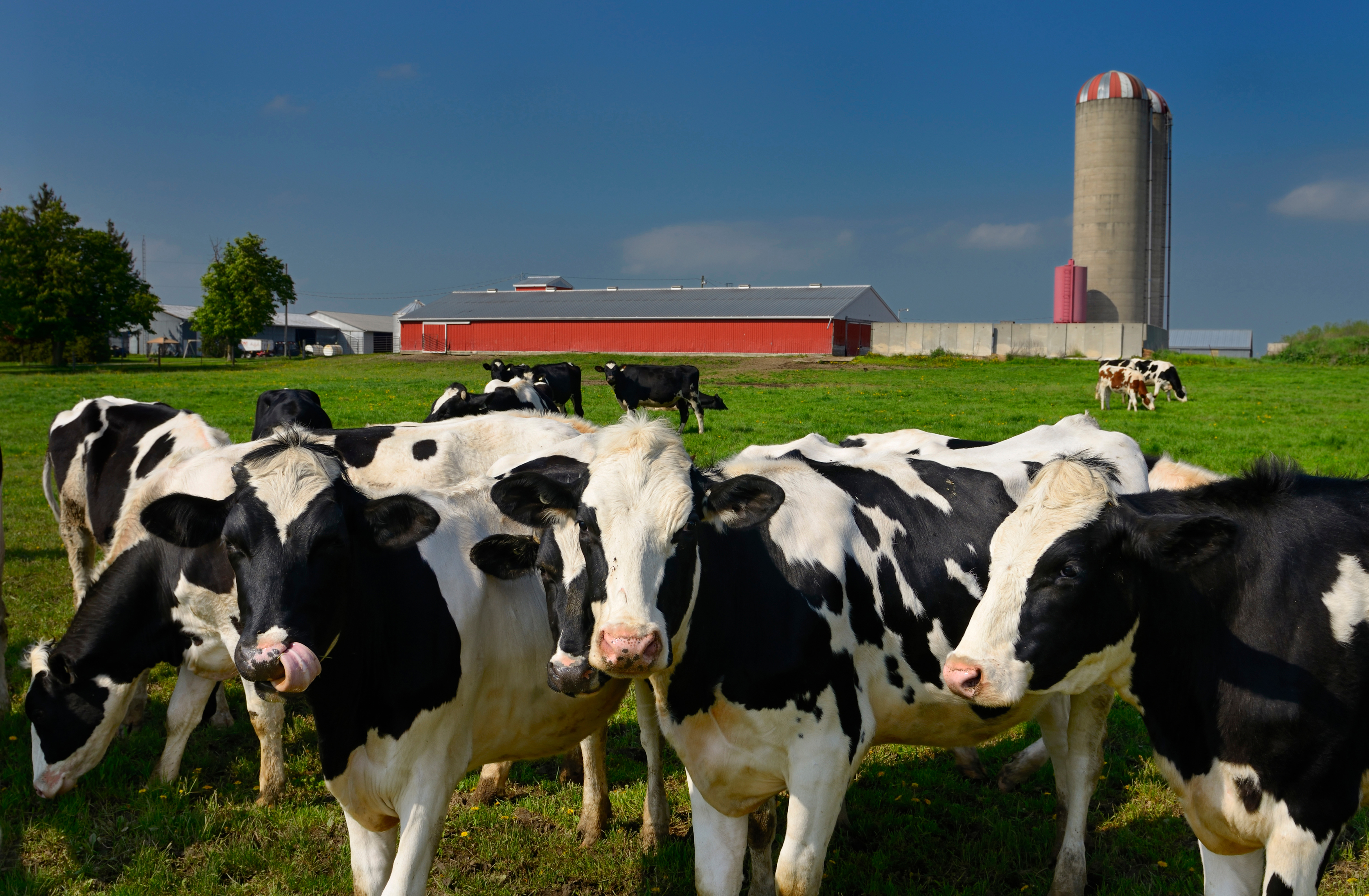
Ontario farmers grow the feed crops they need for their livestock. The major crops include corn, hay, soybeans, and wheat. Ontario leads the provinces in the production of eggs and poultry.
Ontario is also Canada’s leading producer of fruits and vegetables. Orchards and vineyards of the famous Niagara fruit belt produce apples, grapes, peaches, strawberries, and other small fruits. The chief vegetables grown in the province include beans, cabbage, carrots, cucumbers, onions, peas, peppers, potatoes, sweet corn, and tomatoes. Tobacco, which grows along Lake Erie, is among the leading cash crops in Ontario.
Ontario also has the largest floriculture industry in Canada. Many growers raise flowers and vegetables indoors to protect the plants from the weather and to control the growth of the plants. Greenhouse vegetables are primarily grown in the Leamington area.
Mining.
Most of Ontario’s mining income comes from the production of metal ores. Ontario is a leading province in the production of nonfuel minerals.
Copper, gold, and nickel are among Ontario’s most valuable mineral products. Gold-producing areas are scattered throughout the Canadian Shield region. The Hemlo gold field, near Marathon, and a mine at Red Lake are the leading gold-producing areas. The Greater Sudbury area is Canada’s center of nickel production. Copper is mined in the Greater Sudbury and Timmins areas.
Other leading mined products in Ontario include petroleum products, platinum, sand and gravel, and stone. Ontario is Canada’s leading producer of platinum and stone. Natural gas and petroleum have been found in southern Ontario and beneath the waters of Lake Erie. Sand and gravel are obtained primarily from pits in the southern part of the province. Granite, limestone, and marble from Ontario grace buildings around the world.
Electric power and utilities.
Hydroelectric plants, nuclear power plants, and plants that burn natural gas supply almost all of Ontario’s electric power. Ontario and the state of New York share the water of Niagara Falls under terms of a 1910 treaty between Canada and the United States. Other utility companies provide the province’s people with gas and water service.
Transportation.
Waterways have played an important part in the history of Ontario. French explorers traveled up the Ottawa River in canoes. Early canals, particularly the Rideau and Trent systems, carried passengers and freight. The St. Lawrence Seaway, which was completed in 1959, brought oceangoing ships to the inland ports (see Saint Lawrence Seaway).
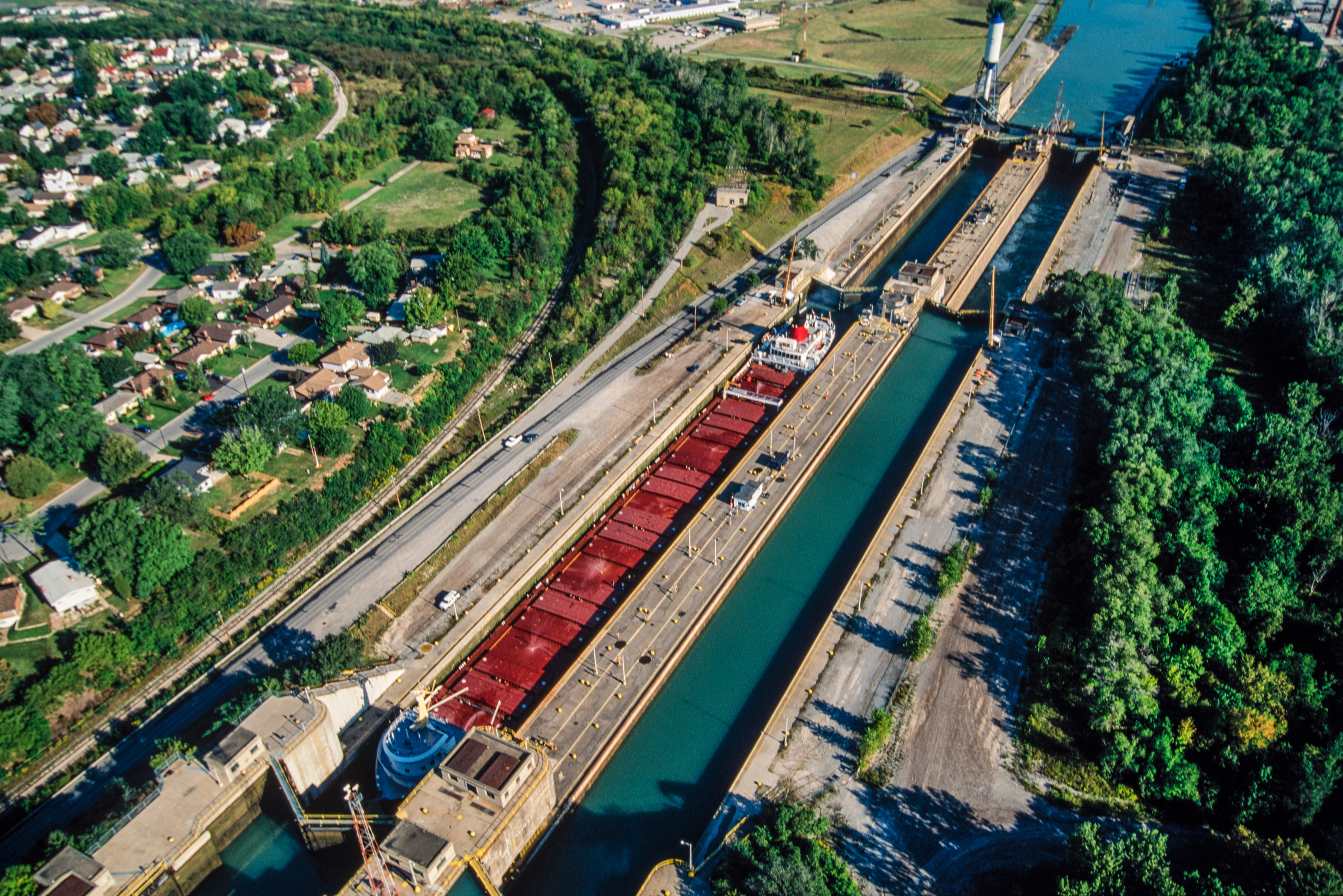
During the navigation season, from late March or early April to late December, many freighters travel between the ports of Ontario and those of the United States. Ships carrying grain crowd the docks of Thunder Bay on Lake Superior.
Toronto Pearson International Airport, just outside Toronto, is Canada’s largest, busiest airport. A number of government, industrial, and private airlines carry passengers and supplies to distant mining and lumbering camps in northern Ontario.
Ontario has about a fifth of Canada’s total railways. Southern Ontario has Canada’s finest railway network. Toronto is the chief rail center of the province. The Canadian National Railway, the Canadian Pacific Railway, and VIA Rail are the largest railways in Ontario. The province owns the Ontario Northland Railway, whose main line runs through the clay belt and the silver-mining region to James Bay. 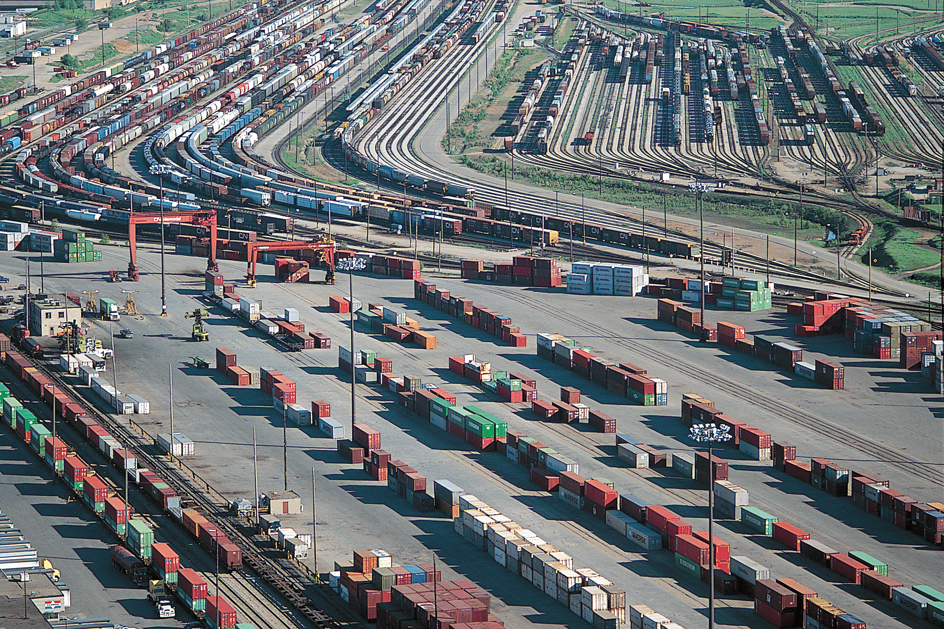
Thousands of miles of highways crisscross Ontario. Part of the east-west Trans-Canada Highway runs across Ontario. A 510-mile (821-kilometer) expressway stretches from Windsor to the Quebec border.
Communication.
Louis Roy, a Frenchman from Quebec, published the first newspaper of the Ontario region. His paper, the Upper Canada Gazette, or American Oracle, first appeared in 1793 in Newark (now Niagara-on-the-Lake). York (now Toronto) became the capital of Ontario in 1797, and the Gazette moved there in 1798. It was published until 1849.
Today, The Globe and Mail, the National Post of Toronto, and the Toronto Star are among the leading daily newspapers. Ontario’s other dailies include the Toronto Sun, the Ottawa Citizen, the Ottawa Sun, The Hamilton Spectator, The London Free Press, and The Windsor Star.
Ontario’s first radio station, CKOC, began broadcasting in Hamilton in 1922. The first TV station, CBLT, was founded in Toronto in 1952. Today, Ontario has about 200 radio stations and 30 TV stations. Cable television systems and Internet providers serve many Ontario communities.
Government
Lieutenant governor
of Ontario represents the British monarch, Canada’s official head of state, in the province. The lieutenant governor is appointed by the governor general in council, the governor general of Canada acting with the advice and consent of the Cabinet. The position of lieutenant governor is largely ceremonial.

Premier
of Ontario is the actual head of government. Ontario, like the other provinces and Canada itself, has a parliamentary government. The premier is an elected member of the Legislative Assembly and is usually leader of the Assembly’s majority party. The head of Ontario’s government was called the premier until 1906, when the title was changed to prime minister. In 1972, Prime Minister William Davis changed the title back to premier.
The premier presides over a cabinet called the Executive Council. The council includes ministers chosen by the premier from members of the premier’s party in the Assembly. Many ministers direct one or more government ministries. The Executive Council, like the premier, resigns if it loses the support of a majority of the Assembly.
Legislative Assembly
of Ontario is a one-house legislature that makes the provincial laws. The Assembly has 124 members who are elected from 124 electoral districts called ridings. The members of the Assembly serve four-year terms. 
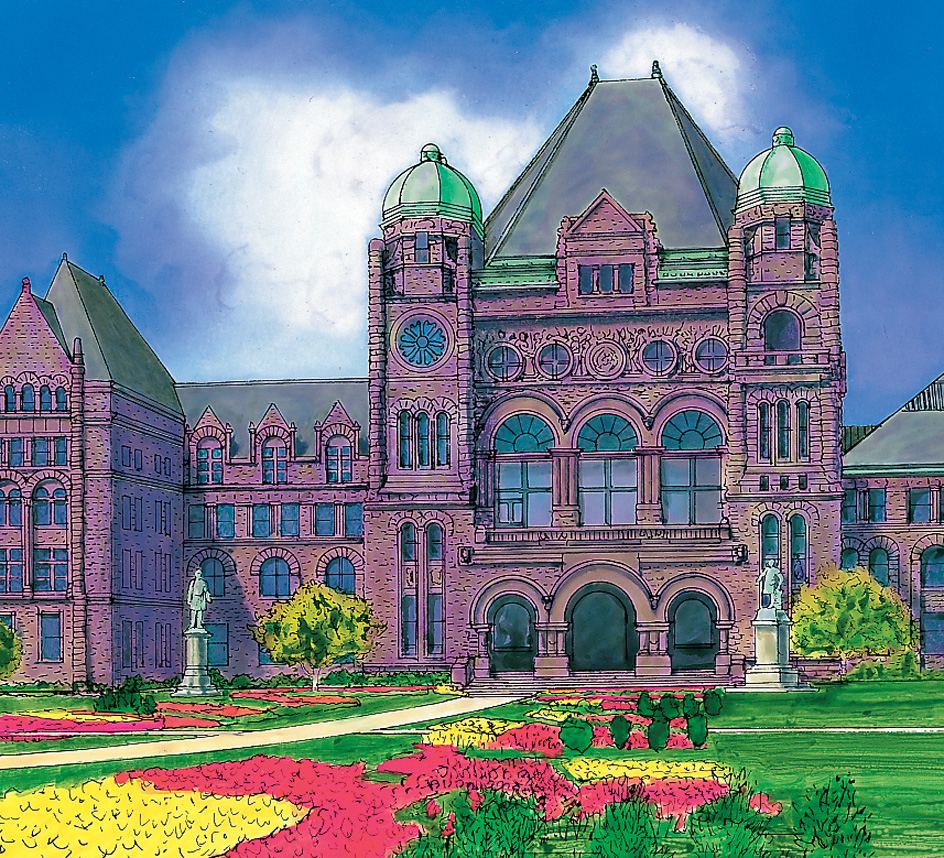
Courts.
Ontario’s highest court is the Court of Appeal. It consists of a chief justice, an associate chief justice, and about 30 other justices.
Ontario’s Superior Court of Justice hears major civil, criminal, and family cases. It has a chief justice, an associate chief justice, eight regional senior judges, a senior judge of the Family Court, and hundreds of other full-time judges. The Superior Court also contains the Divisional Court, the Small Claims Court, and the Family Court. The Divisional Court hears reviews of provincial administrative action and some Superior Court appeals. The Small Claims Court hears minor civil cases. The Family Court hears all aspects of family law disputes. The governor general of Canada, with the advice and consent of the Cabinet, appoints the Superior Court justices, who may serve until age 75.
The Ontario Court of Justice handles provincial offenses and some family and young offenders cases. It has a chief justice, two associate chief justices, seven regional senior judges, and hundreds of other full-time judges. The provincial lieutenant governor in council appoints the judges, who may serve until age 65. With annual approval from the chief justice, the judges may serve until age 75.
Ontario also has specialized courts called Gladue courts or Indigenous peoples courts. These courts handle some aspects of criminal cases involving Indigenous people. They consider Indigenous peoples’ background and the historical treatment of Indigenous people.
Local government.
The basic unit of local government in Ontario is the municipality. A municipality may be called a city, town, township, or village. A municipal council governs each municipality. The council makes decisions about public services and how to finance them. It consists of a leader, called a mayor or a reeve, and a number of elected councilors or aldermen. Municipal governments raise money primarily by collecting property taxes from residents of the municipality.
In some areas of the province, where it is more efficient to do so, a county, district, or regional government administers services to a group of municipalities. A warden heads each county council, and a regional chair heads each regional council. A county council consists of elected members from the constituent municipalities. The method of selecting a regional council varies. Ontario’s only district government, the District Municipality of Muskoka, provides the same kinds of services that county and regional governments provide.
In northern Ontario, which is sparsely populated, District Social Service Administration Boards and Local Service Boards provide municipal services over broad geographical areas. Ontario also has a number of Consolidated Municipal Service Managers. These organizations serve to integrate the social services and community health services of separate municipalities.
Revenue.
Taxes collected by the provincial government provide about two-thirds of the province’s general revenue (income). Most of this money comes from taxes on personal and corporate income and retail sales. Other important revenue sources include taxes on gasoline and tobacco. About one-sixth of the revenue comes from the federal government.
Politics.
Ontario has four major political parties—the provincial Progressive Conservative, Green, Liberal, and New Democratic parties. The Progressive Conservative Party was formerly named the Conservative Party, and today its members are usually called simply Conservatives. Of the four parties, the Greens and New Democrats are the most left-leaning and the Conservatives are the most right-leaning. Other provincial parties include the Communist, Family Coalition, Freedom, Libertarian, Northern Ontario, and Trillium parties.
The Liberals and Conservatives have controlled Ontario’s government for most of its history. But a couple of other parties have governed for isolated periods. In 1919, during an economic depression, the United Farmers of Ontario took over the government. Under the leadership of Ernest C. Drury, the party governed until 1923. The New Democrats controlled the province from 1990 to 1995. Ontario citizens must be at least 18 years of age to vote in federal or provincial elections.
History
Original inhabitants.
Three major Indigenous groups lived in what is now Ontario when European explorers first arrived. The Anishinaabe (also known as the Ojibwe or Chippewa) hunted beavers and small game in the forests north and east of Lake Superior and in southern Ontario. The Cree lived in the north, and west of Lake Superior. The Wendat (also called the Huron) lived between Lake Huron and Lake Ontario. They depended mainly on cultivated crops for food. The Wendat often fought with the Iroquois, who lived in several settlements south of Lake Ontario.
European exploration.
The first European to explore the Ontario region was Étienne Brulé of France. Samuel de Champlain, the founder of Quebec, sent Brulé to the area in 1610. In 1613, Champlain paddled up the Ottawa River. In 1615, he journeyed farther south, into the Lake Huron area, where he joined Brulé. Brulé had been living with the Wendat for a time and had adopted their language and customs. Champlain found the Lake Huron region rich in fur-bearing animals. French fur traders followed his course to collect pelts. They traveled deep into the forests, accompanied by Indigenous guides. The French traded with the Indigenous peoples, swapping guns and knives for furs. In the 1620’s and 1630’s, French explorers, including Brulé and Jean Nicolet, explored the Lake Superior region, Lake Michigan, and beyond.
Early settlement.
French missionaries followed the fur traders into the Ontario region. In 1639, Jesuit priests built Fort Sainte Marie as the center of a group of missions among the Wendat. These missions were known together as Huronia. Weakened by malnutrition and diseases that the Europeans had brought with them, the Wendat became easy prey for the Iroquois. Under pressure from the Iroquois, the Jesuits and the Wendat fled Huronia in 1648 and 1649.
During the 1650’s and 1660’s, French explorers entered the region north of Lake Superior. These explorers included Pierre Esprit Radisson and Médard Chouart, Sieur des Groseilliers. Their explorations led to the founding of a trading company called the Hudson’s Bay Company in London, England (see Hudson’s Bay Company).
In 1763, at the end of the French and Indian War, also called the Seven Years’ War, France gave the Ontario region to Britain (now the United Kingdom). By then, only a few scattered French settlements remained near what are now Kingston, Niagara Falls, and Windsor.
Little further settlement took place until 1784. That year, after the American Revolution, people loyal to England began arriving in the Ontario region from the United States. About 6,000 of these United Empire Loyalists, as they were called, had arrived by 1785. They settled near present-day Kingston and Windsor, and on the Niagara Peninsula, an isthmus that connects Ontario and New York. The Loyalists had lost their homes and wealth. The British government gave them food, clothing, land, livestock, and seed. About 4,000 other settlers also arrived from the United States. From the 1760’s to the 1860’s, the British Crown negotiated 30 treaties with Indigenous peoples to secure land for new settlement. These treaties are known as the Upper Canada treaties.
Upper Canada.
In 1791, the southern part of what is now Ontario became the colony of Upper Canada. Newark (now Niagara-on-the-Lake) was the capital. The British government appointed a lieutenant governor to govern the colony. The lieutenant governor appointed a 7-member Legislative Council and an Executive Council to advise him. The people elected a 16-member Legislative Assembly. The first lieutenant governor, Colonel John Graves Simcoe, promoted roadbuilding and expanded settlement. In 1793, Simcoe chose the site of present-day Toronto for a new colonial capital he named York. The government finished moving to York in 1797. The city was renamed Toronto in 1834.
Gradually, more settlers arrived, some in organized groups. A group of Pennsylvania Dutch, most of whom were descended from German immigrants, settled near what is now Kitchener. Many people migrated from the United States to acquire cheap land. Traders from the Hudson’s Bay Company posts in Canada’s Far North settled with their families in the southern towns. Most of these people were English or Scottish.
Around 1805, the North West Company, a fur trading company based in Montreal, established Fort William as its inland headquarters. Fort William was on the northwest shore of Lake Superior, just north of the United States’ northern border. It became a major transfer point for goods in the Canadian fur trade.
The War of 1812 between the United Kingdom and the United States tested the loyalty of Upper Canada’s settlers. Well over half the people of the colony were former U.S. citizens. Many preferred to stay out of the war. British troops, aided by Indigenous people and some Canadian militia, halted invading U.S. forces in several battles in Upper Canada.
Early growth and political unrest.
The population of Upper Canada more than quadrupled from 1812 to 1842. Private investors formed land companies, such as the Canada Company, to sell land and promote immigration. Bytown (now Ottawa) and other towns prospered. The export of wood and wheat to the United Kingdom helped fuel the economy. Canals, mills, small factories, and roads were built. The Rideau and Trent canals and the first Welland canal date from this period. In 1825, the Erie Canal linked Lakes Erie and Ontario with New York City. Many Irish immigrants, motivated by Upper Canada’s prosperity, arrived in the region during the early and mid-1800’s. 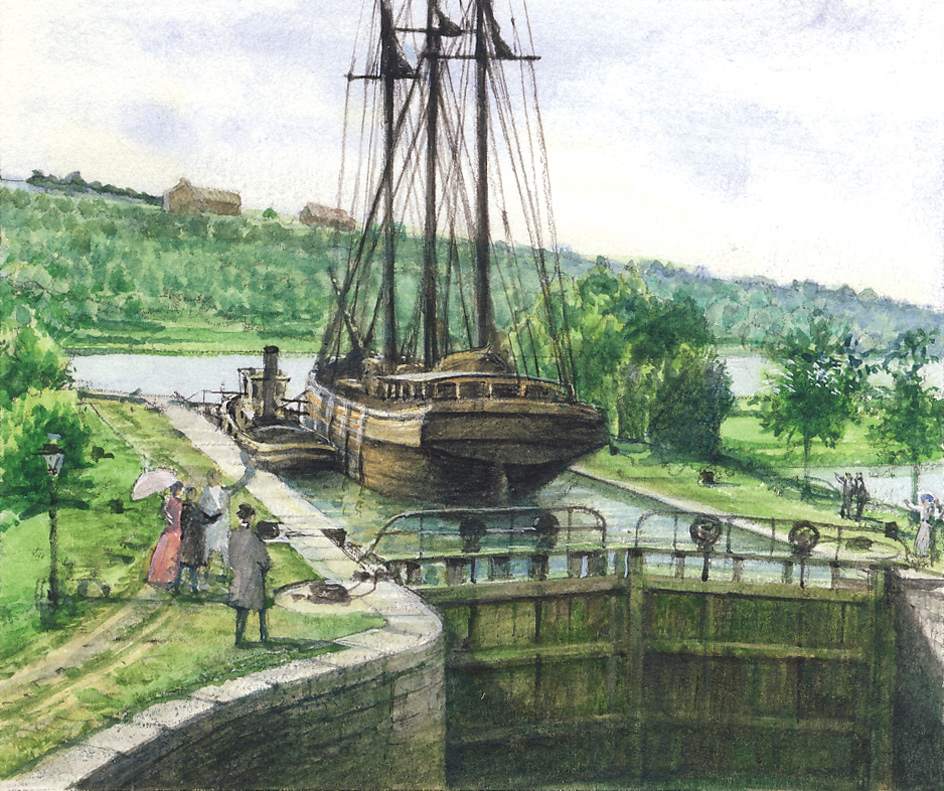
In the 1830’s, many Upper Canadians became dissatisfied with their government. Under the colony’s system of government, the people elected only the Legislative Assembly. But substantial power lay with the lieutenant governor and with the councils that he appointed to assist him. The members of these councils were often called the Family Compact and generally represented the wealthy and powerful people of the colony. The Legislative Council often blocked legislation that the Legislative Assembly had passed. Such legislation included building roads and schools and providing free land to settlers.
The Family Compact and the British government blocked political reforms that would have given the people more power. William Lyon Mackenzie, a member of the Legislative Assembly, and a group of several hundred followers rebelled in 1837. A colonial militia put down the uprising. The government arrested some of the rebels, banished some, and executed two. Mackenzie and others fled to the United States. (See Rebellions of 1837.)
In 1840, the British Parliament passed the Act of Union. This act, which took effect in 1841, united Upper Canada and Lower Canada (part of present-day Quebec) into a single colony called the Province of Canada. The areas that had been Upper and Lower Canada became known as Canada West and Canada East, respectively. The British hoped that the French-speaking majority in Canada East would be absorbed into the English-speaking majority in Canada West. But French- and English-speaking Reform movement members agreed to protect their distinct rights and also demanded more political freedom. They achieved some success in 1848, when the Province of Canada gained responsible government. Under responsible government, the head of government and a cabinet govern for as long as they have the support of a majority of the people’s elected representatives.
By 1851, the population of Canada West had reached 925,000. Such growth in the Province of Canada led to an increasing need for expansion northward. In 1850, the Crown negotiated two treaties called the Robinson treaties with Indigenous peoples. The treaties gave the Crown access to lands around Lakes Huron and Superior for settlement and natural-resource extraction. They also led to the establishment of reserves, hunting and fishing rights, and an annuity (annual payment) for the Indigenous peoples.
Confederation.
In 1864, politicians from the Province of Canada proposed a federal union of all the British colonies in eastern North America. All the colonies except Prince Edward Island and Newfoundland agreed to join the confederation. On July 1, 1867, the British North America Act created the Dominion of Canada. New Brunswick, Nova Scotia, Ontario, and Quebec became provinces in the Dominion. Ottawa was chosen as the federal capital. Sir John A. Macdonald of Ontario became the first prime minister of Canada. John S. Macdonald, no relation to him, was Ontario’s first premier. 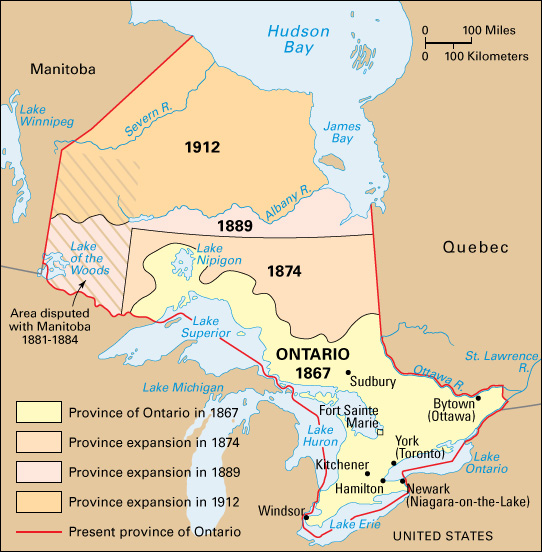
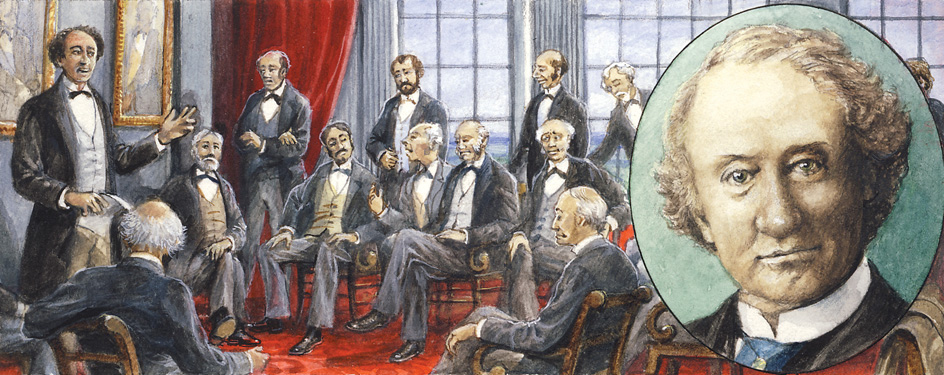
Progress as a province.
Following confederation, Ontario’s economy grew slowly at first. However, the development of scientific methods of agriculture and the use of machinery led to an increase in farming, and lumbering expanded in the Canadian Shield region. New railroad tracks expanded land transportation, and a network of canals opened water navigation in the province. Manufacturing increased, and the cities of Toronto and Hamilton became important business and industrial centers. Despite this slow yet substantial economic growth, many Ontarians moved to the United States for better job opportunities. In 1883, railroad construction crews found the world’s richest copper-nickel deposits near Sudbury (now part of Greater Sudbury). Major mining did not begin until after 1892, when a copper company developed a practical process for separating copper and nickel.
From the late 1800’s to the early 1900’s, the British Crown negotiated 11 treaties known as the Numbered Treaties with Indigenous groups. Three of these—Treaties 3, 5, and 9—secured Canada’s access to Indigenous lands and natural resources in northern and western Ontario.
In the early 1900’s,
mining and manufacturing began to increase rapidly. The city of Cobalt became a thriving mining center after a huge silver deposit was discovered nearby in 1903. Mineral exploration took place throughout the Canadian Shield. Within a few years, prospectors discovered many new deposits of gold, silver, and other minerals. The region soon became one of the world’s richest mining areas.
A pulp and paper industry developed in Ontario during the early 1900’s, and soon grew to have major importance. Ontario’s automobile industry began in 1904, when ferryboats first carried automobile parts across the Detroit River from Detroit, Michigan, to Windsor. Windsor became an automobile assembly center. In 1906, the provincial government established the Hydro-Electric Power Commission of Ontario. This agency developed Niagara Falls and other hydroelectric sources.
By 1911, more Ontarians lived in urban than in rural communities, and more people worked in business and manufacturing than as farmers. In 1912, Ontario’s northern boundary was extended from north of the Albany River to Hudson and James bays. This expansion gave the province its present area. The outbreak of World War I (1914-1918) hastened Ontario’s economic development. Ontario led the provinces in the production of weapons and other military supplies. During the war, more volunteers in Canada’s armed forces came from Ontario than from any other single province. In 1917, women in Ontario gained the right to vote in provincial elections.
During the 1920’s, prospectors developed new mines in the northern forest regions. Many Finns, Scandinavians, and French-speaking Canadians from Quebec settled in these areas. Automobile production continued to increase. The iron and steel and the pulp and paper industries prospered. This prosperity ended with the Great Depression of the 1930’s. During the Depression, Ontario experienced labor unrest. This led to an increase in labor unions during the 1940’s.
The mid-1900’s.
World War II (1939-1945) put an end to the Great Depression in Ontario. During the war, Ontario’s factories, farms, and mines increased production to help arm and feed the Allied armies. Later, hundreds of thousands of Europeans left their war-torn countries and migrated to Ontario. More than half of the 3 million people who settled in Canada from 1945 to 1970 made their homes in Ontario. The population rose from about 4 million to 7 1/2 million. The largest numbers of immigrants were from Germany, Italy, the United Kingdom, South and East Asia, and the Caribbean.
The war stimulated Ontario’s manufacturing production, which peaked in the early 1950’s. Discoveries of various minerals contributed to the economic boom. An iron ore deposit discovered near Atikokan in northwestern Ontario supplied much of the province’s iron ore from the 1940’s through the 1970’s. In 1952, a geologist found one of the world’s largest uranium ore deposits at Elliot Lake. In 1953, prospectors found another huge uranium deposit near Bancroft and a rich zinc-copper field at Lake Manitouwadge.
Also during the 1950’s, energy companies laid pipelines to carry natural gas and oil to Ontario from western Canada. The oil, piped to Sarnia, led to the development of that city’s refining industry. Ontario’s iron and steel industry grew rapidly. The province also expanded hydroelectric stations at Niagara Falls and other sites.
In the 1960’s, factory production doubled once more. In 1964, an American mineral company discovered a huge field of copper, silver, and zinc ores near Timmins. An open-pit mine began operating there in 1966.
Ontario’s growing industries required great increases in electric power. The province looked to nuclear energy to meet its needs. Canada’s first nuclear reactor had gone into operation near Chalk River, Ontario, in 1945. In 1962, Canada’s first nuclear power station began operating at Rolphton, Ontario. Its success led to the development of Canada’s first full-scale nuclear station, which began operating at Douglas Point, Ontario, in 1967. A nuclear plant at Pickering, Ontario, opened in 1971.
Not all Ontarians benefited equally from the prosperity of the 1950’s and 1960’s. In the north and east, forestry expanded, but manufacturing developed less than it did in the southeast. In 1968, the Canadian Senate reported that 13 percent of Ontarians—over 1 million people—lived in poverty. During this period, Indigenous communities suffered not only from economic hardship. They also suffered from government policies requiring Indigenous children to attend special residential schools, and allowing the removal of children from their homes to be placed in foster and adoptive homes.
The late 1900’s.
Ontario’s strong economy helped Toronto emerge as Canada’s leading financial center in the 1960’s and 1970’s. Many banks and other financial institutions, including the Toronto Stock Exchange, Canada’s major stock exchange, have headquarters there.
Tourism became increasingly important to Ontario’s economy during the late 1900’s. The province’s forests and lakes attracted growing numbers of vacationers. Historic sections of Toronto and other Ontario cities also attracted visitors.
In 1972, the province passed the Ontario Health Insurance Plan. Under the plan, Ontario residents pay small or no premiums, depending on their ability to pay. The plan provides financial assistance with most hospital and physician bills up to a minimum level of care.
Canada suffered an economic recession during the 1970’s and 1980’s. This economic downturn worsened in the 1990’s. Many people blamed a free trade agreement made between Canada and the United States in 1989. The agreement called for the elimination of tariffs and other trade barriers between the two countries. It removed government restrictions against U.S. imports, thus creating greater competition for Ontario manufacturers. The passage of the North American Free Trade Agreement (NAFTA) in 1994 strengthened the original agreement between Canada and the United States.
Beginning in the 1980’s, many people from developing countries in Asia and from the Middle East and the Caribbean migrated to Ontario in search of better opportunities. In 1995, the United Nations declared Toronto the most culturally diverse city in the world.
Ontario faced a growing budget deficit during the 1980’s and early 1990’s. In an effort to reduce the deficit, Progressive Conservative Premier Michael D. Harris cut spending on a wide range of government programs. For example, he reduced funding for welfare, cities, health care, education, and the environment. Harris also lowered income taxes. Although the government’s actions caused controversy, the Conservatives won reelection in 1999.
From 1998 to 2001, several Ontario cities, including Hamilton, Ottawa, and Toronto, were merged with surrounding communities and rural areas. The mergers were intended to reduce the duplication of municipal services.
The early 2000’s.
The Liberals governed Ontario from 2003 to 2018. Kathleen Wynne, who served as premier from 2013 to 2018, was Ontario’s first woman premier and its first openly gay premier. The Conservatives, led by Doug Ford, won general elections in 2018 and 2022.
